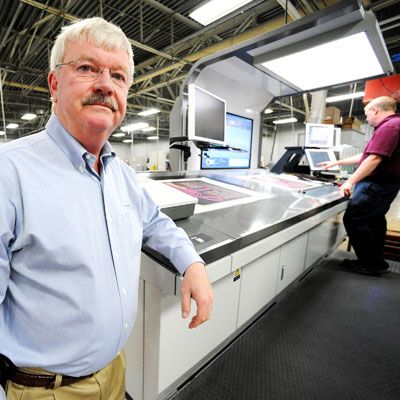An Augusta printer reaps the rewards of a $15 million investment
 photo/Amber Waterman
Rick Tardiff, CEO of J.S McCarthy, has used technology to gain out-of-state clients at a time when many printing companies are struggling
photo/Amber Waterman
Rick Tardiff, CEO of J.S McCarthy, has used technology to gain out-of-state clients at a time when many printing companies are struggling
Rick Tardiff, CEO of J.S. McCarthy printers in Augusta, knew the company was at a crossroads in 2007 when he realized most of its customers were three-to-five hours away and its future growth lay in attracting more long-distance customers. The solution, Tardiff says, was investing in technology that eliminated the need for site visits by clients and streamlined production. Five years and $15 million in investments later, the company expects to log $35 million in revenue this year, a 50% increase over 2010.
The upgrades, which include two new Komori presses, also expanded the 60-year-old company's capacity to print new products, opening new markets. Gov. Paul LePage joined J.S. McCarthy employees and other dignitaries in a recent ceremony marking the installation of a third Komori press. The new press can simultaneously print both sides of a 20-inch by 40-inch sheet of paper in less than a quarter of a second. The company's productivity has sky rocketed, turning around print jobs that once took 25 hours in less than eight, says Tardiff. To aid its growth, the company added 15 new employees in the last year and plans to add another 10.
Mainebiz recently chatted with Tardiff about his company's success. The following is an edited transcript.
Mainebiz: How did you come to this decision in 2007 to invest in technology?
Rick Tardiff: Today, 65% of our business is outside of Maine; back then it was less but still significant. We knew if we wanted to grow, we had to get outside of Maine, and there tended to be pushback from people who were used to having their work done locally — they needed to go to a printer for a press check because the quality of the work was sometimes suspect. By employing technology, we broke down that distance barrier.
Can you give me an example?
Our technology allows customers to view proofs online and they can annotate the proofs online. We use a color-calibrated monitor that allows you to print to the monitor as opposed to printing to a hard proof. We also put proofing devices in our customers' locations so they can try things out at the design stage. We have a full-time person who goes to clients to train them on Adobe software.
What other factors have affected your growth?
We put our factory in order, adopting lean manufacturing principles, and made these investments. We went out and purchased other printing companies that were struggling with the economy and hadn't invested. We were able to get their work and produce it for much less money in much less time. We called this our tuck-in plan. Our plant produced all the work, but we kept the sales and customer service people of [the companies we purchased.] Since 2007, we've brought in companies from Boston, Portland and Connecticut.
What are your new markets?
Recently we've done a lot of printing for packaging, and that seems to be an area growing for us. And we do a lot of college industry publications around the country, as well as work for greeting card companies and New York City ad agencies. What we've done to help insulate ourselves from a tough economy is to spread ourselves regionally and through diversified products so we're not exposed in any one area. n










Comments